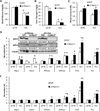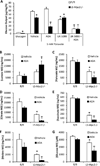Loss of Mitochondrial Pyruvate Carrier 2 in the Liver Leads to Defects in Gluconeogenesis and Compensation via Pyruvate-Alanine Cycling
- PMID: 26344101
- PMCID: PMC4598280
- DOI: 10.1016/j.cmet.2015.07.028
Loss of Mitochondrial Pyruvate Carrier 2 in the Liver Leads to Defects in Gluconeogenesis and Compensation via Pyruvate-Alanine Cycling
Abstract
Pyruvate transport across the inner mitochondrial membrane is believed to be a prerequisite for gluconeogenesis in hepatocytes, which is important for the maintenance of normoglycemia during prolonged food deprivation but also contributes to hyperglycemia in diabetes. To determine the requirement for mitochondrial pyruvate import in gluconeogenesis, mice with liver-specific deletion of mitochondrial pyruvate carrier 2 (LS-Mpc2(-/-)) were generated. Loss of MPC2 impaired, but did not completely abolish, hepatocyte conversion of labeled pyruvate to TCA cycle intermediates and glucose. Unbiased metabolomic analyses of livers from fasted LS-Mpc2(-/-) mice suggested that alterations in amino acid metabolism, including pyruvate-alanine cycling, might compensate for the loss of MPC2. Indeed, inhibition of pyruvate-alanine transamination further reduced mitochondrial pyruvate metabolism and glucose production by LS-Mpc2(-/-) hepatocytes. These data demonstrate an important role for MPC2 in controlling hepatic gluconeogenesis and illuminate a compensatory mechanism for circumventing a block in mitochondrial pyruvate import.
Copyright © 2015 Elsevier Inc. All rights reserved.
Figures







Comment in
-
Diabetes: Important role for MPC complex in hepatic gluconeogenesis.Nat Rev Endocrinol. 2015 Nov;11(11):629. doi: 10.1038/nrendo.2015.162. Epub 2015 Sep 22. Nat Rev Endocrinol. 2015. PMID: 26391977 No abstract available.
Similar articles
-
Hepatic Mitochondrial Pyruvate Carrier 1 Is Required for Efficient Regulation of Gluconeogenesis and Whole-Body Glucose Homeostasis.Cell Metab. 2015 Oct 6;22(4):669-81. doi: 10.1016/j.cmet.2015.07.027. Epub 2015 Sep 3. Cell Metab. 2015. PMID: 26344103 Free PMC article.
-
Diabetes: Important role for MPC complex in hepatic gluconeogenesis.Nat Rev Endocrinol. 2015 Nov;11(11):629. doi: 10.1038/nrendo.2015.162. Epub 2015 Sep 22. Nat Rev Endocrinol. 2015. PMID: 26391977 No abstract available.
-
Disruption of hepatic mitochondrial pyruvate and amino acid metabolism impairs gluconeogenesis and endurance exercise capacity in mice.Am J Physiol Endocrinol Metab. 2024 Apr 1;326(4):E515-E527. doi: 10.1152/ajpendo.00258.2023. Epub 2024 Feb 14. Am J Physiol Endocrinol Metab. 2024. PMID: 38353639 Free PMC article.
-
The mitochondrial pyruvate carrier mediates high fat diet-induced increases in hepatic TCA cycle capacity.Mol Metab. 2017 Nov;6(11):1468-1479. doi: 10.1016/j.molmet.2017.09.002. Epub 2017 Sep 18. Mol Metab. 2017. PMID: 29107293 Free PMC article.
-
Enzymes involved in l-lactate metabolism in humans.Mitochondrion. 2013 Nov;13(6):615-29. doi: 10.1016/j.mito.2013.08.011. Epub 2013 Sep 9. Mitochondrion. 2013. PMID: 24029012 Review.
Cited by
-
Effects of hepatic mitochondrial pyruvate carrier deficiency on de novo lipogenesis and gluconeogenesis in mice.iScience. 2023 Oct 12;26(11):108196. doi: 10.1016/j.isci.2023.108196. eCollection 2023 Nov 17. iScience. 2023. PMID: 37942005 Free PMC article.
-
Overexpression of the peroxin Pex34p suppresses impaired acetate utilization in yeast lacking the mitochondrial aspartate/glutamate carrier Agc1p.FEMS Yeast Res. 2019 Dec 1;19(8):foz078. doi: 10.1093/femsyr/foz078. FEMS Yeast Res. 2019. PMID: 31711143 Free PMC article.
-
Metabolic Mechanisms Connecting Alzheimer's and Parkinson's Diseases: Potential Avenues for Novel Therapeutic Approaches.Front Mol Biosci. 2022 Jun 16;9:929328. doi: 10.3389/fmolb.2022.929328. eCollection 2022. Front Mol Biosci. 2022. PMID: 35782864 Free PMC article. Review.
-
Mitochondrial pyruvate metabolism and glutaminolysis toggle steady-state and emergency myelopoiesis.J Exp Med. 2023 Sep 4;220(9):e20221373. doi: 10.1084/jem.20221373. Epub 2023 May 30. J Exp Med. 2023. PMID: 37249600 Free PMC article.
-
The Role of Pi, Glutamine and the Essential Amino Acids in Modulating the Metabolism in Diabetes and Cancer.J Diabetes Metab Disord. 2020 Aug 19;19(2):1731-1775. doi: 10.1007/s40200-020-00566-5. eCollection 2020 Dec. J Diabetes Metab Disord. 2020. PMID: 33520860 Free PMC article. Review.
References
-
- Adams MD, Raman P, Judd RL. Comparative effects of englitazone and glyburide on gluconeogenesis and glycolysis in the isolated perfused rat liver. Biochemical pharmacology. 1998;55:1915–1920. - PubMed
-
- Burgess SC, Leone TC, Wende AR, Croce MA, Chen Z, Sherry AD, Malloy CR, Finck BN. Diminished hepatic gluconeogenesis via defects in tricarboxylic acid cycle flux in peroxisome proliferator-activated receptor gamma coactivator-1alpha (PGC-1alpha)-deficient mice. The Journal of biological chemistry. 2006;281:19000–19008. - PMC - PubMed
-
- Casetta B, Tagliacozzi D, Shushan B, Federici G. Development of a method for rapid quantitation of amino acids by liquid chromatography-tandem mass spectrometry (LC-MSMS) in plasma. Clinical chemistry and laboratory medicine : CCLM / FESCC. 2000;38:391–401. - PubMed
Publication types
MeSH terms
Substances
Grants and funding
- R42 AA021228/AA/NIAAA NIH HHS/United States
- R01 DK078187/DK/NIDDK NIH HHS/United States
- P30 DK56341/DK/NIDDK NIH HHS/United States
- T32 DK007120/DK/NIDDK NIH HHS/United States
- T32 DK007296/DK/NIDDK NIH HHS/United States
- P30 DK052574/DK/NIDDK NIH HHS/United States
- R56 DK078184/DK/NIDDK NIH HHS/United States
- R01 DK104735/DK/NIDDK NIH HHS/United States
- R01 DK078184/DK/NIDDK NIH HHS/United States
- DK007120/DK/NIDDK NIH HHS/United States
- P30 DK20579/DK/NIDDK NIH HHS/United States
- T32 DK07296/DK/NIDDK NIH HHS/United States
- P30 DK056341/DK/NIDDK NIH HHS/United States
- P01 DK058398/DK/NIDDK NIH HHS/United States
- P30 DK52574/DK/NIDDK NIH HHS/United States
- P30 DK020579/DK/NIDDK NIH HHS/United States
LinkOut - more resources
Full Text Sources
Other Literature Sources
Molecular Biology Databases

